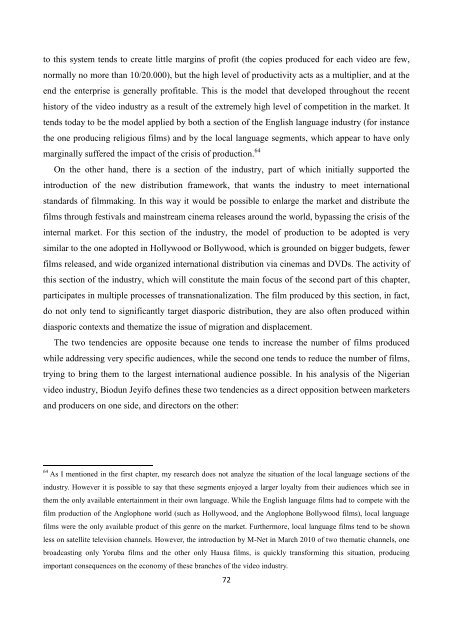Create successful ePaper yourself
Turn your PDF publications into a flip-book with our unique Google optimized e-Paper software.
to this system tends to create little margins of profit (the copies produced for each video are few,normally no more than 10/20.000), but the high level of productivity acts as a multiplier, and at theend the enterprise is generally profitable. This is the model that developed throughout the recenthistory of the video industry as a result of the extremely high level of competition in the market. Ittends today to be the model applied by both a section of the English language industry (for instancethe one producing religious films) and by the local language segments, which appear to have onlymarginally suffered the impact of the crisis of production. 64On the other hand, there is a section of the industry, part of which initially supported theintroduction of the new distribution framework, that wants the industry to meet internationalstandards of filmmaking. In this way it would be possible to enlarge the market and distribute thefilms through festivals and mainstream cinema releases around the world, bypassing the crisis of theinternal market. For this section of the industry, the model of production to be adopted is verysimilar to the one adopted in Hollywood or Bollywood, which is grounded on bigger budgets, fewerfilms released, and wide organized international distribution via cinemas and DVDs. The activity ofthis section of the industry, which will constitute the main focus of the second part of this chapter,participates in multiple processes of transnationalization. The film produced by this section, in fact,do not only tend to significantly target diasporic distribution, they are also often produced withindiasporic contexts and thematize the issue of migration and displacement.The two tendencies are opposite because one tends to increase the number of films producedwhile addressing very specific audiences, while the second one tends to reduce the number of films,trying to bring them to the largest international audience possible. In his analysis of the Nigerianvideo industry, Biodun Jeyifo defines these two tendencies as a direct opposition between marketersand producers on one side, and directors on the other:64As I mentioned in the first chapter, my research does not analyze the situation of the local language sections of theindustry. However it is possible to say that these segments enjoyed a larger loyalty from their audiences which see inthem the only available entertainment in their own language. While the English language films had to compete with thefilm production of the Anglophone world (such as Hollywood, and the Anglophone Bollywood films), local languagefilms were the only available product of this genre on the market. Furthermore, local language films tend to be shownless on satellite television channels. However, the introduction by M-Net in March 2010 of two thematic channels, onebroadcasting only Yoruba films and the other only Hausa films, is quickly transforming this situation, producingimportant consequences on the economy of these branches of the video industry.72
















